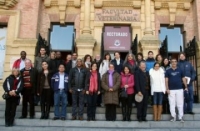Spanish olive groves kidnap 6% of national emissions of CO2
Escrito porG.C.
The “Arable Crops” team of the University of Córdoba defends the crucial role of agriculture in the fight against climate change
Development of a new method to analyze authenticity of vinegar
Escrito porFundación Descubre
This technique allows examination of vinegar properties and with lower cost of the quality control process
A new method to characterize pathogen contamination in pork meat
Escrito porFundación Descubre
This technique, based on mathematical calculations, enables definition of optimal storage temperature for these products, with the aim to avoid appearance and development of microorganisms such as Salmonella or Listeria monocytogenes.
Members of Vitenol Research Group receive Jose Luis Messiah award
Escrito porPress Office
Members of 'Vitenol' Research Group at the University of Córdoba, which is part of the Agrifood Campus of International Excellence of Andalusia (ceiA3) received the XXXV Research Award 'José Luis Iglesias Messiah' granted by Santa Ana University Center to best research work presented at the Symposium of Enology and Viticulture in Tierra de Barros.
El proyecto COMET-LA, seleccionado para debatir el futuro de Europa como un actor global
Escrito porG.C. - E.L
La investigadora de la Universidad de Córdoba y el ceiA3 María del Mar Delgado expondrá en Bruselas la experiencia acumulada por el proyecto en la gestión participativa y ascendente de recursos naturales
A sensor to analyze Iberian pig authenticity in real time
Escrito porG.C.-E.L.
Researchers from the School of Agricultural and Forestry Engineering (ETSIAM) at the University of Córdoba have developed several applications for real time determination of food profuct quality and authenticity in sectors such as Iberian pork and fruit and vegetables. For this, experts used portable spectral sensors based on NIRS technology, which is based on a relationship between spectral measurements and physical and chemical parameters in food and allows instant, nondestructive analysis of different product samples, such as loin, ham, plums, asparagus or orange.


